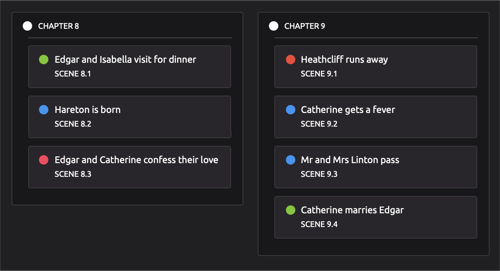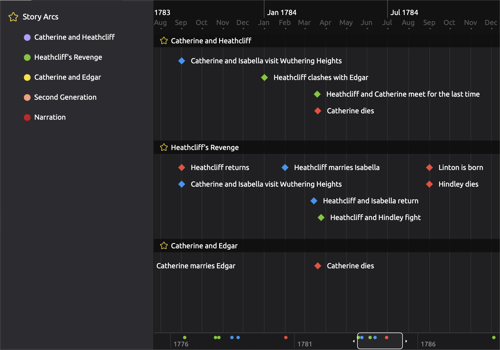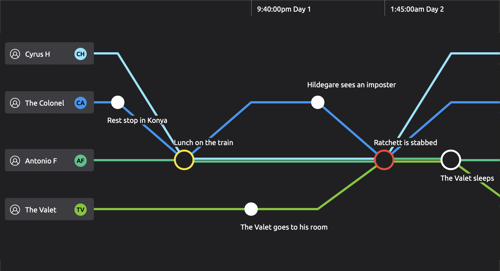Making Time: 5 Ways Writers Prepare for Success With Timelines

Every year, we’re lucky to have great sponsors for our nonprofit events. Aeon Timeline, a 2022 NaNoWriMo sponsor, is a visual hub for your entire story. NaNoWriMo writers can try out a free trial of Aeon Timeline through December 15! In this post, the folks at Aeon share a few ways that making a timeline for your novel can help your story:
If you are like me your story has been gnawing inside you for months. An intriguing premise; a character to explore; a surprise twist; a cliffhanger ending—something is telling you that you are the person to write this story.
Yet every year, only one in ten Wrimos make it to the end. Over 200,000 promising novels are abandoned—typically in the sticky middle stages.
At Aeon Timeline, we believe that visual planning with timelines can bring purpose to your writing, add depth to your characters, and sustain your creative energy until the end.
With help from authors David Williams and Andrew Hanson, let’s look at why so many stories fail in the middle stages, and the planning you can do now to avoid those mid-novel traps.
1. Steer your story in the right directionWriting a novel any time is tough; finishing one in a month is crazy. To get to the finish line, you need to make sure every scene is pulling in the right direction.
I find it easier to maintain momentum when I have the lure of a compelling climax to write towards. Creating this sense of direction is what building a visual story timeline is all about.
Don’t worry: 50,000 words provides abundant room for creativity. Planning a few signposts won’t change that, but it will make writing less stressful.
“I like to write fast and I like to write loose. Aeon Timeline allows me to do more of that, because it encourages me to be spontaneous in the space in-between. It’s actually going to enhance your creativity, and give you more freedom.”
– David Williams
 2. Perfect your pacing with the right time frame
2. Perfect your pacing with the right time frameWe writers talk a lot about setting, but stories live in time as much as they live in space. Time is crucial to controlling pace and tension.
Ask yourself:
What is the chronology of my story? What are the key moments and when do they need to happen?What if I compressed my timeline? Would it increase tension, and force my characters to act impulsively? Or do my characters need more time to grow?You could use pen and paper, but using a digital timeline encourages you to freely experiment and find new possibilities:
3. Cultivate characters with purpose
“Looking at this on the timeline, I thought, that’s actually the beginning and end of the story. I’ve taken 20-odd years of information, and reframed it around a single weekend. Just the freedom to be able to throw these events around made me realize I had been getting it entirely wrong.”
– David Williams
You determine every choice for your characters, but you want them to bring their own goals and motive to every scene. To pull off this magic trick, each character’s stakes need to be high enough that they can’t simply walk away.
To ensure authentic choices, it helps to build thorough backstories for your characters and your world. What recent events instigated your story? How are they compelling your characters into action? Which historical scars and social pressures provoke their reactions in each scene?
By plotting these histories visually, you can cross reference personal and world events—prompting fresh insights about your characters.
“I start with the characters, and then flesh out the backstory events to make sure that the story logic makes sense. By story logic, I really mean that the events leading up to the present day of the story make sense to the reader.”
– Andrew Hanson
 4. Amplify tension throughout your middle chapters
4. Amplify tension throughout your middle chaptersThe first quarter of your book is done—your characters have taken that first irreversible step. The final chapters are whispering to you with the siren call of crisis and resolution.
But first, you have half a novel to increase stakes and layer pressure on your characters. That is a lot of empty space to fill with complications that don’t feel repetitive or contrived. You can drop another dead body, but can you really drop five?
It is easy to see why so many stories are abandoned in the middle. Why not plan your escalations in advance, while you have time to experiment and your story feels fresh?
If a better idea strikes while writing, that’s great! But if it doesn’t, your story timeline can keep you on solid ground:
“The timeline is my barometer of story. It gives me an idea of where the pressure points are in a story, whether the story is working or not. It’s my eyes and ears on the story.”
– Andrew Hanson
 5. Plan scenes as agents of change
5. Plan scenes as agents of changeWe have all stumbled on that one scene that doesn’t want to be written. You can’t wait to throw yourself at the next crisis point, if you could just get that one scene right. But until then… Everything. Just. Stops.
Often, this block is surprisingly simple: your scene isn’t doing anything:
“The most important thing that every single scene has to have is change — external plot change or internal character change, but ideally both. If I am struggling with the writing of a scene, I can go into Aeon Timeline and fill in the details to work out where the scene has gone wrong.
– Andrew Hanson
Aeon Timeline is a flexible visual hub for planning your entire story. You can find detailed case studies describing how David and Andrew use Aeon Timeline on our website.
Download a free trial on Mac, Windows and iOS. Discounts are available to all NaNoWriMo participants until December 15. To claim, log into your NaNoWriMo account and visit the Offers page.
Chris Baty's Blog
- Chris Baty's profile
- 63 followers



